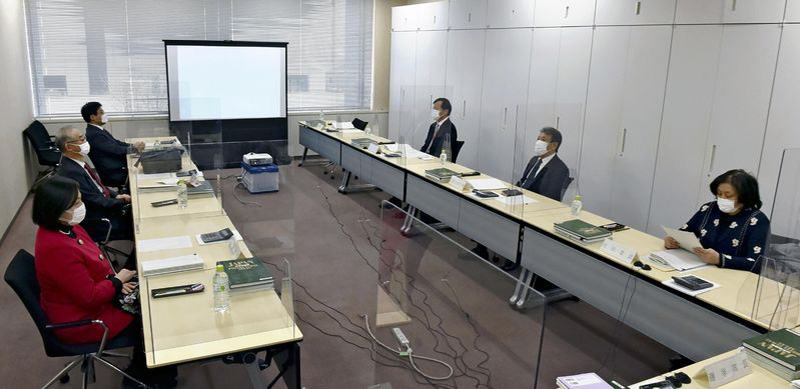
The Council on the House of Representatives Electoral District holds a meeting in Chiyoda Ward, Tokyo, on Jan. 31.
9:42 JST, March 4, 2022
A government council addressing the difficult task of redistricting constituencies for future House of Representatives elections has been working to finalize details.
The Council on the House of Representatives Electoral District will submit its plan for revising the constituencies to Prime Minister Fumio Kishida by late June.
Because the demarcation of districts has a significant impact on the electoral situation, the current “plus 10, minus 10” plan — in which 10 new constituencies are created while 10 current ones are eliminated across 15 prefectures — faces a host of problems before being finalized.
Thinking comprehensively
“How can regions be divided, thinking of connections between cities, wards, towns and villages, means of transportation, and traditions?” Teikyo University Prof. Sadafumi Kawato, who heads the council, said at a press conference after a meeting on Jan. 31.
“I don’t think there is any one decisive factor. We have to think in a comprehensive manner.”
Such a remark reflects just how difficult the job of district rezoning is. At the meeting, members of the council discussed opinions from prefectural governors that were submitted to the council through late January.
The council has been working on redistricting since the law that established the body was amended in 2016. The law calls for the rezoning of constituencies in: 1) 15 prefectures, including Tokyo, in which “plus 10, minus 10” is achieved using the Adams Method based on the population of Japanese nationals in the 2020 national census, and 2) Osaka and Fukuoka prefectures, which have constituencies with more than double the population of Tottori Constituency No. 2, which is the smallest in the nation with 273,973 citizens, based on the census.
The council formulated a policy for the rezoning Feb. 21 and plans to finish the practical work by June 25, which is set as the deadline for reporting to the prime minister.
The law stipulates that the rezoning should be done rationally while considering administrative zones, geographical circumstances, transportation and other aspects in a comprehensive manner.
Competition among heavyweights
The biggest hurdle is how to rezone the electoral districts in the 10 prefectures that are slated to lose a lower house seat.
There are various ways in each prefecture in which municipalities can be combined in order to fulfill the criteria that the vote disparity per ballot with Tottori Constituency No. 2 be less than double.
Ultimately, the council will make the final decision, but a source in the Internal Affairs and Communications Ministry said, “Because it is a life-or-death situation for lawmakers whose constituencies will be rezoned, it is difficult to ensure fairness in the process.”
In Yamaguchi Prefecture, which will see its constituencies decreased from four to three, the most likely scenario is that its Constituency No. 3, which includes the city of Ube and has a population of 295,776, will be split up, with the sections absorbed into neighboring Constituency No. 1, which includes Yamaguchi City and has a population of 422,326, and Constituency No. 4, which includes Shimonoseki and has a population of 283,241.
Ube is the home turf of Foreign Minister Yoshimasa Hayashi, while lower house member Masahiro Komura is from Yamaguchi City and former Prime Minister Shinzo Abe is from Shimonoseki.
Rezoning in Yamaguchi Prefecture, from which such influential lawmakers of the ruling Liberal Democratic Party hail, has the possibility of also affecting the power balance within the party.
Ehime Prefecture, which will also lose one of its four constituencies, has compiled five rezoning plans of its own, all of which assure a vote disparity less than double.
In the last rezoning in 2017, Mie Prefecture, which lost a lower house seat, got involved in a heated debate on how to handle the city of Matsusaka.
Matsusaka had wanted to be integrated into the electoral district to the south that includes Ise, but that would have resulted in a constituency with a relatively larger population than the others in the prefecture. In the end, Matsusaka was
Avoiding a triple split
Another focus is what to do with the 105 cities, wards and towns that will be divided up into different electoral districts.
In metropolitan Tokyo, where the number of constituencies will increase from the current 25 to 30, 17 wards and cities are already split up into different districts, leaving many to wonder whether further division was possible.
Said a source in the metropolitan election administration commission: “Right now there are some divided into two. If a municipality is further divided into three, it will also affect the commission’s work, so I hope it can be avoided.”
A person who had served on the commission said, “It looks like the commission members will not easily come to an agreement and will be working right up to the deadline.”
Prof. Yutaka Shinada of Kobe University, an expert of electoral systems, said, “Though it is difficult to find a balance between population, geographical conditions and other factors, the council needs to explain the reasons behind its conclusion as rationally as possible.”
Dissent within the LDP
By Masashi Nakata
Yomiuri Shimbun Staff Writer
Dissent has emerged within the ruling Liberal Democratic Party over the “plus 10, minus 10” plan for redistricting constituencies. Many of the prefectures in line for reductions are political strongholds for the party.
In the four prefectures of Shiga, Okayama, Yamaguchi and Ehime, the LDP has a monopoly on the lower house seats.
“It’s maddening,” Former LDP Secretary General Toshihiro Nikai said during a radio program on Jan. 10. “Can such a thing be tolerated?”
Nikai was openly expressing his discontent about the reduction of constituencies in his political home turf of Wakayama Prefecture.
He further emphasized in a BS television program on Jan. 19, “Once a Diet seat is lost, it will never come back.”
Within the LDP, more than a few members have voiced concerns that “it will become harder for the voices of people in provincial regions to reach the government.”
Hiroyuki Hosoda, lower house speaker from the LDP, is pushing his own plan for “plus 3, minus 3” that is not based on the Adams method.
In December last year, he opened a Pandora’s Box by remarking, “It’s useless to only reduce [districts] in rural areas and increase them in urban areas based on a number calculated in our heads.”
A mid-ranking LDP member from a prefecture facing a reduction agreed, saying, “Even with the ‘plus 3, minus 3’ [plan], the vote disparity can be pushed below double.”
However, the ‘plus 3, minus 3’ option has not gained a large following within the party. That is because the adoption of the Adams method was decided through a bill sponsored by the LDP and others after debate within the party.
If the law is amended without the Adams method being used even once, the LDP will invite criticism that the legislative action was only for the party’s benefits and interests. There is also concern that the Supreme Court will again rule that the election is being held in “a state of unconstitutionality.”
There is also an opinion that vote disparity should be reduced by increasing the total number of lower house seats, instead of reducing those in rural areas.
“It’s OK to consider the option to increase the total number [of lower house seats],” Hiroshige Seko, secretary general of the LDP caucus in the House of Councillors, said at a press conference on Jan. 11.
But LDP members have shown little desire to debate increasing the number.
"Politics" POPULAR ARTICLE
-

Japan to Support Central Asian Logistics Route That Bypasses Russia, Plan to Be Part of Upcoming Summit in Tokyo
-

Japan to Tighten Screening of Foreigners’ Residential Status by Providing Information of Nonpayment of Taxes
-

Chinese, Russian Bombers Flew Unusual Path by Heading Toward Tokyo; Move Likely Meant to Intimidate Japan
-

Japan Plans National Database to Track Foreign Ownership of Real Estate, Land as It Weighs New Rules
-

Up to 199,000 Deaths Estimated From Mega-Tsunami; Most Recent Occurrence Took Place in 17th Century
JN ACCESS RANKING
-

Tokyo Economic Security Forum to Hold Inaugural Meeting Amid Tense Global Environment
-

Keidanren Chairman Yoshinobu Tsutsui Visits Kashiwazaki-Kariwa Nuclear Power Plant; Inspects New Emergency Safety System
-

Imports of Rare Earths from China Facing Delays, May Be Caused by Deterioration of Japan-China Relations
-

University of Tokyo Professor Discusses Japanese Economic Security in Interview Ahead of Forum
-

Japan Pulls out of Vietnam Nuclear Project, Complicating Hanoi’s Power Plans
























